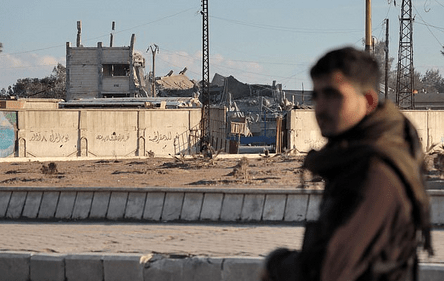
Four hundred Islamic State terrorists are missing after the Syrian jailbreak
Hundreds of ISIS fighters are missing following a week-long attack on the largest prison in Syria holding captured jihadis.
Kurdish-led forces operating al-Sina prison in Al-Hasakah, a city in northeast Syria, said today that 400 militants are unaccounted for after they regained control of the jail on January 26 following almost a week of fighting.
Another 374 ISIS fighters were killed in the jail-break, the Syrian Defense Forces claimed, adding that 40 of their own fighters died along with 77 prison staff.
The attack marks the largest assault that ISIS has mounted since the defeat of its ‘caliphate’ in 2019, involving hundreds of fighters, explosive-laden cars and extensive planning that the SDF believes was carried out overseas.
Before the attack, al-Sina prison was though to house around 3,500 prisoners including captured male fighters and 800 young boys thought to have links to the group – dubbed ‘Cubs of the Caliphate’.
The attack on al-Sina began around 7pm on January 20 when a car bomb was detonated at the main gates of the jail, the SDF said today in its first detailed report on the fighting.
Jihadist fighters and suicide bombers then streamed into the prison, fighting with SDF guards and breaching internal walls in an attempt to free the prisoners.
At the same time, prisoners who appeared to have been tipped off about the timing and date of the attack launched their own assault on guards – taking some hostage and killing others, the SDF said.
ISIS fighters also drove cars full of weapons up to the prison, so that any fighters who escaped could arm themselves and continue the battle.
The jihadists had also dug tunnels in buildings surrounding the prison, an SDF press release said, to help assist in the escape plot.
Several buildings around the jail – which is actually a series of converted school buildings – were also captured by ISIS, including part of a university.
ISIS’s plan was to liberate the jail, then continue to a wider attack on the surrounding neighbourhoods in order to capture government and military outposts, the SDF said.
But a force of some 10,000 SDF fighters were deployed to stop them – according to analysts at Washington’s Middle East Institute – along with American and British special forces.
They surrounded the prison and nearby neighbourhoods, fighting building-to-building for six days before declaring the area completely free of ISIS fighters.
All ISIS prisoners remaining at the jail have since been moved to a more-secure site to prevent future jail breaks, the SDF added.
As the dust settles following the attack, the US urged allied countries to repatriate citizens suspected of having links to ISIS from Syria, rather than leave them languishing in jails in the Middle East.
Around 12,000 suspected ISIS militants are still in jail in Syria, though it is not clear exactly how many of those are foreign citizens.
Another 65,000 family members associated with those fighters are also stuck in internment camps, many looking for a way to get back to countries whose governments have largely disowned them.
Washington called on its partners ‘to improve the secure and humane detention of ISIS fighters, support rehabilitation initiatives, and urgently repatriate their nationals and other detainees remaining in northeast Syria.’
Senior IS leaders were captured or killed during the fighting, State Department spokesman Ned Price said today, praising the SDF ‘for their heroic and effective response to the sustained ISIS attack.’
Most nations have been reluctant to repatriate their IS suspects from northeast Syria, preferring to leave them in the custody of Kurdish authorities.
But the Kurdish administration has long warned it does not have the capacity to hold, let alone put on trial, all the IS fighters captured in years of operations.
Authorities say more than 50 nationalities are represented in Kurdish-run prisons holding more than 12,000 IS suspects.
The Kurdish administration’s foreign policy chief Abdulkarim Omar said it was up to the international community to put foreign jihadists on trial or repatriate them.
The IS threat is ‘like a fireball, it gets more dangerous and complicated with time,’ he told AFP.
The self-declared IS caliphate, established in 2014, once straddled large parts of Iraq and Syria, a country wracked by civil war since 2011.
After five years of military operations conducted by local and international forces, IS’ last rump was eventually flushed out on the banks of the Euphrates in eastern Syria in March 2019.
Source: Daily Mail





